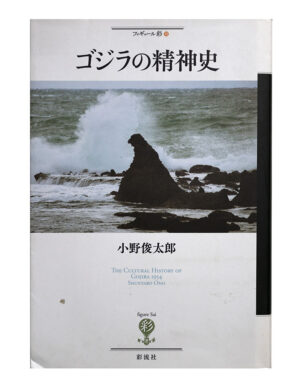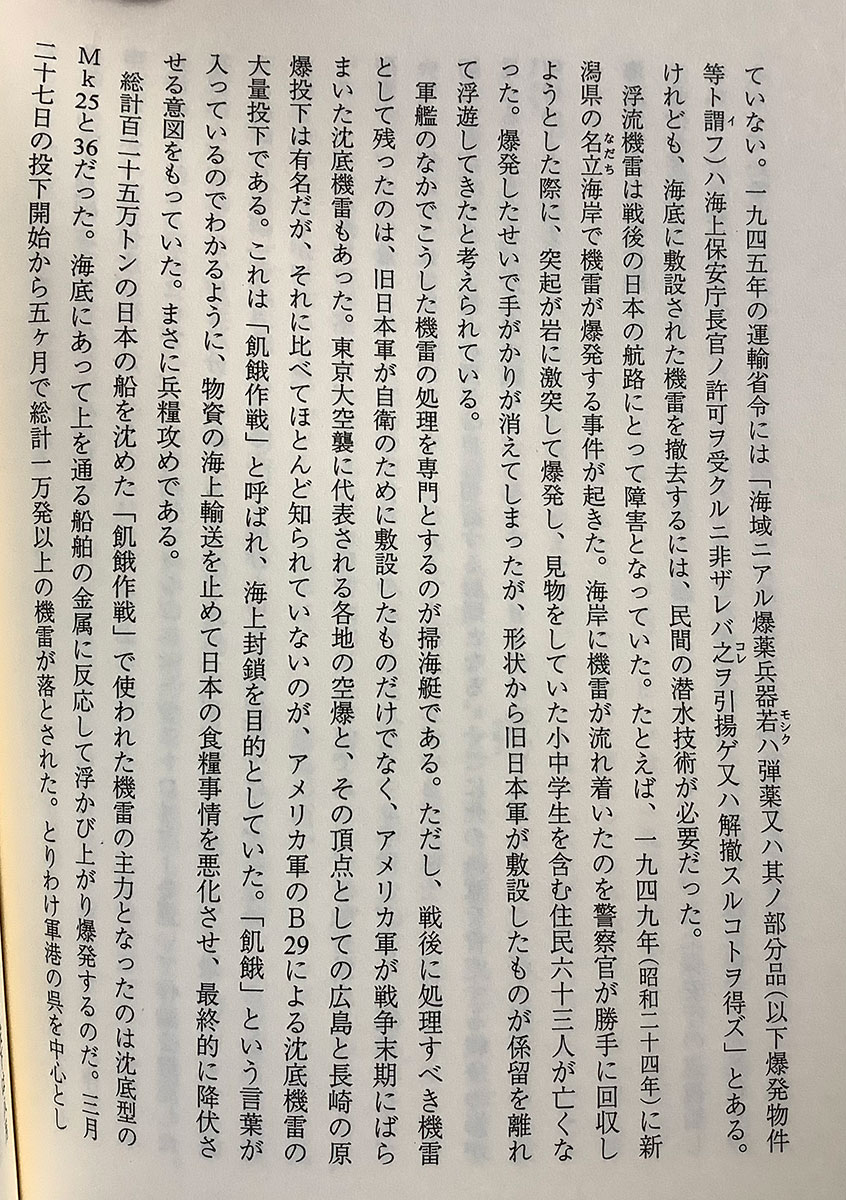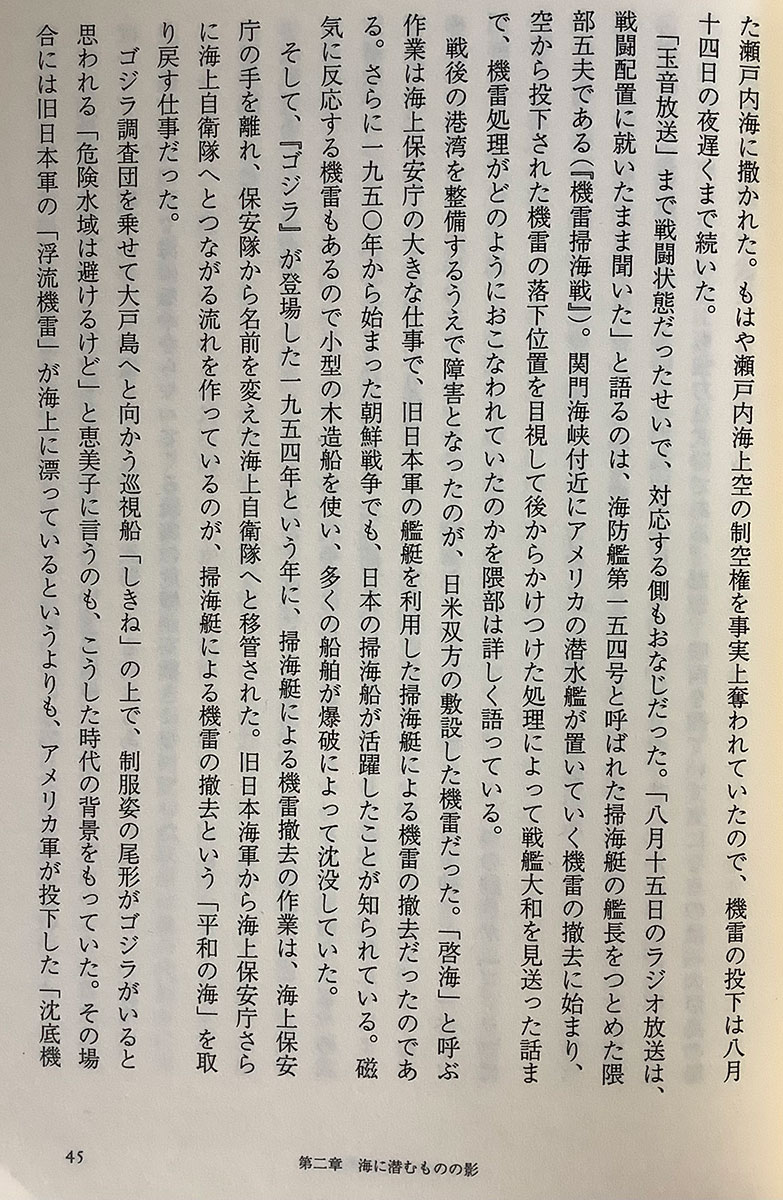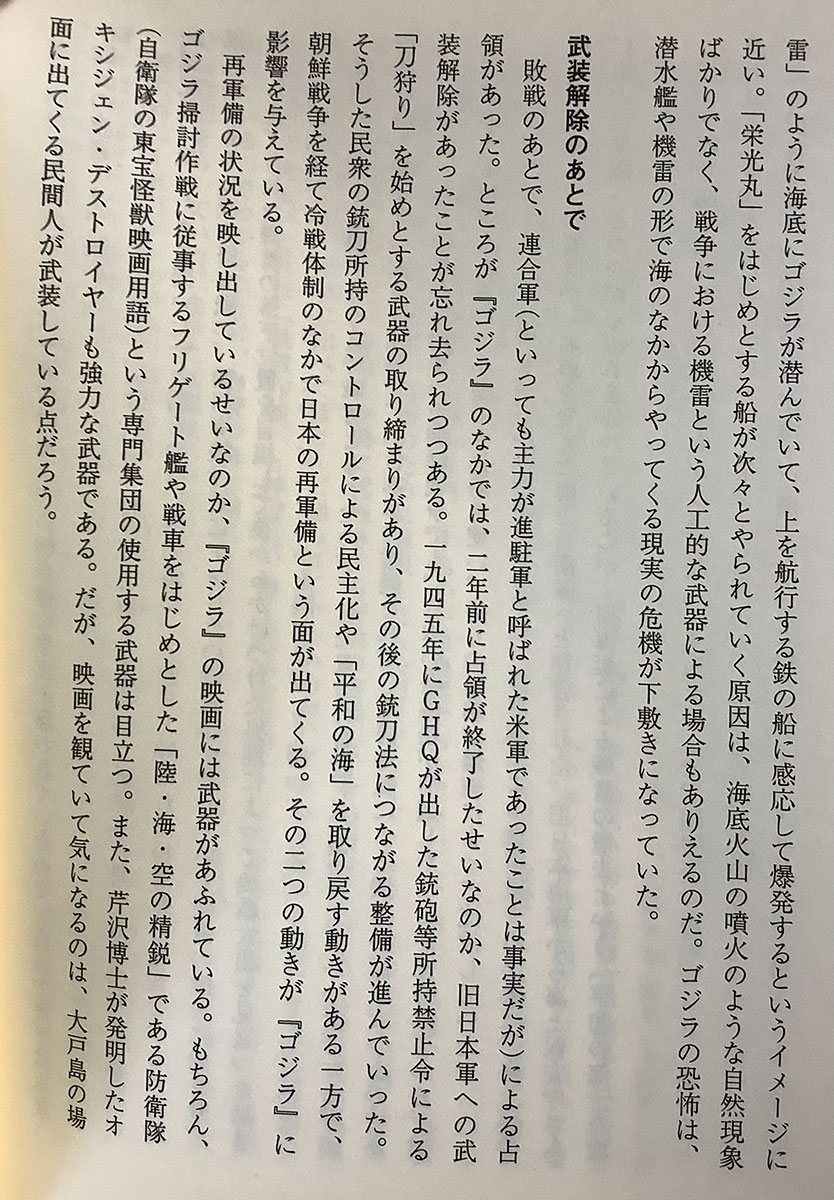11.5.2022
The Cultural History of Godzilla – Pt 19


P 44
かつて海上保安庁が港湾整備のために機雷撤去の仕事をしてきたことはあまり知られモンクていない。一九四五年の運輸省令には「海域ニアル爆薬兵器若ハ弾薬又ハ其ノ部分品(以下爆発物件等ト謂フ) ハ海上保安庁長官ノ許可ヲ受クルニ非ザレバ之ヲ引揚ゲ又ハ解撤スルコトヲ得ズ」とある。 けれども、海底に敷設された機雷を撤去するには、民間の潜水技術が必要だった。
It is not well known that the Japan Coast Guard used to remove mines for port maintenance. A 1945 Ordinance of the Ministry of Transport states, “Explosive weapons, ammunition, or parts thereof (hereinafter referred to as explosive articles, etc.) shall not be withdrawn from the sea unless permission has been obtained from the Director General of the Japan Coast Guard. It is written that it cannot be dismantled. However, civilian diving technology was needed to remove mines laid on the seafloor.
浮流機雷は戦後の日本の航路にとって障害となっていた。たとえば、一九四九年(昭和二十四年)に新潟県の名立海岸で機雷が爆発する事件が起きた。海岸に機雷が流れ着いたのを警察官が勝手に回収しなだちようとした際に、突起が岩に激突して爆発し、見物をしていた小中学生を含む住民六十三人が亡くなった。爆発したせいで手がかりが消えてしまったが、形状から旧日本軍が敷設したものが係留を離れ浮遊してきたと考えられている。
Floating mines were an obstacle to Japan’s shipping routes after the war. For example, in 1949 (Showa 24), a mine exploded on Nadachi Beach in Niigata Prefecture. When a police officer tried to recover a mine that washed up on the coast, the protrusion crashed into a rock and exploded, killing 63 residents, including elementary and junior high school students who were watching. rice field. The clues disappeared due to the explosion, but from the shape, it is thought that the thing laid by the former Japanese army left the mooring and floated.
軍艦のなかでこうした機雷の処理を専門とするのが掃海艇である。ただし、戦後に処理すべき機雷として残ったのは、旧日本軍が自衛のために敷設したものだけでなく、アメリカ軍が戦争末期にばら まいた沈底機雷もあった。東京大空襲に代表される各地の空爆と、その頂点としての広島と長崎の原 爆投下は有名だが、それに比べてほとんど知られていないのが、アメリカ軍のB2による沈底機雷の大量投下である。これは「飢餓作戦」と呼ばれ、海上封鎖を目的としていた。「飢餓」という言葉が入っているのでわかるように、物資の海上輸送を止めて日本の食糧事情を悪化させ、最終的に降伏さ せる意図をもっていた。まさに兵糧攻めである。
Among warships, minesweepers are specialized in clearing such mines. However, mines that remained to be disposed of after the war were not only mines laid by the former Japanese army for self-defense, but also bottom mines that were scattered by the American forces towards the end of the war. The air raids on various locations represented by the Great Tokyo Air Raid, and the atomic bombings of Hiroshima and Nagasaki that culminated in that are well-known, but by comparison, the mass dropping of bottom mines by the U.S. B-2 forces is little known. This was called “Operation Starvation” and was intended as a naval blockade. As you can see from the word “starvation,” it was intended to stop the sea transportation of goods, worsen Japan’s food situation, and eventually surrender. It’s just a weapon attack.
総計百二十五万トンの日本の船を沈めた「飢餓作戦」で使われた機雷の主力となったのは沈底型の Mk25と36だった。海底にあって上を通る船舶の金属に反応して浮かび上がり爆発するのだ。三月 二十七日の投下開始から五ヶ月で総計一万発以上の機雷が落とされた。
The submerged Mk25 and 36 were the main mines used in Operation Starvation, which sank a total of 1.25 million tons of Japanese ships. It is on the bottom of the sea and reacts to the metal of ships passing above, and it floats and explodes. A total of more than 10,000 mines were dropped in five months from the start of the dropping on March 27th.

P 45
とりわけ軍港の呉を中心とした瀬戸内海に撒かれた。もはや瀬戸内海上空の制空権を事実上奪われていたので、機雷の投下は八月 十四日の夜遅くまで続いた。
In particular, it was scattered in the Seto Inland Sea centered around Kure, a naval port. Since air superiority over the Seto Inland Sea had been virtually lost, the dropping of mines continued until late at night on August 14th.
「玉音放送」まで戦闘状態だったせいで、対応する側もおなじだった。「八月十五日のラジオ放送は、戦闘配置に就いたまま聞いた」と語るのは、海防艦第一五四号と呼ばれた掃海艇の艦長をつとめた隈部五夫である(『機雷掃海戦』)。関門海峡付近にアメリカの潜水艦が置いていく機雷の撤去に始まり、空から投下された機雷の落下位置を目視して後からかけつけた処理によって戦艦大和を見送った話まで、機雷処理がどのようにおこなわれていたのかを隈部は詳しく語っている。
Because it was in a battle state until “Jewel Voice Broadcast,” the corresponding side was the same. “I listened to the radio broadcast on August 15 while I was stationed for battle,” says Isao Kumabe, who served as the captain of the minesweeper called Coastal Defense Ship No. 154 (“minesweeping warfare”). Starting with the removal of mines left by an American submarine near the Kanmon Strait, to the story of seeing off the battleship Yamato after seeing the location of the mines dropped from the sky and rushing after them to dispose of them. Kumabe talks in detail about what happened.
Jewel Voice Broadcast. The Hirohito surrender broadcast was a radio broadcast of surrender given by Japanese Emperor Hirohito on August 15, 1945. It announced to the Japanese people that the Japanese Government had accepted the Potsdam Declaration demanding the unconditional surrender of the Japanese military at the end of World War II. (Source: Wikipedia https://en.wikipedia.org/wiki/Hirohito_surrender_broadcast)
戦後の港湾を整備するうえで障害となったのが、日米双方の敷設した機雷だった。「啓海」と呼ぶ 作業は海上保安庁の大きな仕事で、旧日本軍の艦艇を利用した掃海艇による機雷の撤去だったのである。さらに一九五〇年から始まった朝鮮戦争でも、日本の掃海船が活躍したことが知られている。磁気に反応する機雷もあるので小型の木造船を使い、多くの船舶が爆破によって沈没していた。
One of the obstacles to post-war port development was the mines laid by both Japan and the United States. The work called “Keikai” was a major task of the Japan Coast Guard, and it was the removal of mines by minesweepers using ships of the former Japanese military. Furthermore, it is known that Japanese minesweepers played an active role in the Korean War that began in 1950. Small wooden ships were used because some mines reacted to magnetism, and many ships were sunk by explosions.
そして、『ゴジラ』が登場した一九五四年という年に、掃海艇による機雷撤去の作業は、海上保安庁の手を離れ、保安隊から名前を変えた海上自衛隊へと移管された。旧日本海軍から海上保安庁さらに海上自衛隊へとつながる流れを作っているのが、掃海艇による機雷の撤去という「平和の海」を取り戻す仕事だった。
Then, in 1954, when “Godzilla” appeared, the task of removing mines using minesweepers was transferred from the Japan Coast Guard to the Maritime Self-Defense Force, which had changed its name. It was the task of restoring the “sea of peace” by clearing mines with minesweepers, creating a flow from the former Japanese Navy to the Japan Coast Guard and then to the Maritime Self-Defense Force.
ゴジラ調査団を乗せて大戸島へと向かう巡視船「しきね」の上で、制服姿の尾形がゴジラがいると思われる「危険水域は避けるけど」と恵美子に言うのも、こうした時代の背景をもっていた。その場合には旧日本軍の「浮流機雷」が海上に漂っているというよりも、アメリカ軍が投下した「沈底機雷」のように海底にゴジラが潜んでいて、上を航行する鉄の船に感応して爆発するというイメージに近い。
On board the patrol ship Shikine, which carries the Godzilla investigation team to Odo Island, Ogata in uniform tells Emiko, “We’ll avoid dangerous waters,” where Godzilla is thought to be. In that case, rather than the former Japanese military’s “floating mines” drifting on the sea, Godzilla is lurking at the bottom of the sea like the “sinking mines” dropped by the US military, and an iron ship sailing above. It is close to the image of exploding in response to.

P 46
「栄光丸」をはじめとする船が次々とやられていく原因は、海底火山の噴火のような自然現象 ばかりでなく、戦争における機雷という人工的な武器による場合もありえるのだ。ゴジラの恐怖は、 潜水艦や機雷の形で海のなかからやってくる現実の危機が下敷きになっていた。
Eiko Maru and other ships are destroyed one after another not only by natural phenomena such as submarine volcanic eruptions, but also by man-made weapons such as mines in war. Godzilla’s terror was based on real dangers coming from under the sea in the form of submarines and mines.
武装解除のあとで
After disarmament
敗戦のあとで、連合軍(といっても主力が進駐軍と呼ばれた米軍であったことは事実だが)による占領があった。ところが『ゴジラ』のなかでは、二年前に占領が終了したせいなのか、旧日本軍への武 装解除があったことが忘れ去られつつある。一九四五年にGHQが出した銃砲等所持禁止令による「刀狩り」を始めとする武器の取り締まりがあり、その後の銃刀法につながる整備が進んでいった。そうした民衆の銃刀所持のコントロールによる民主化や「平和の海」を取り戻す動きがある一方で、朝鮮戦争を経て冷戦体制のなかで日本の再軍備という面が出てくる。その二つの動きが「ゴジラ」に影響を与えている。
After the defeat, there was an occupation by the Allied Forces (although it is true that the main forces were the US forces called the Occupation Forces). However, in “Godzilla,” perhaps because the occupation ended two years ago, the disarmament of the former Japanese army is being forgotten. In 1945, the GHQ issued a ban on the possession of firearms, etc., and there was a crackdown on weapons such as “sword hunting,” and the development of the Firearms and Swords Law progressed after that. While there are moves to restore democratization and the “sea of peace” by controlling people’s possession of guns and swords, Japan’s rearmament of the Cold War system after the Korean War has also emerged. These two movements influence “Godzilla.”
再軍備の状況を映し出しているせいなのか、『ゴジラ』の映画には武器があふれている。もちろん、ゴジラ掃討作戦に従事するフリゲート艦や戦車をはじめとした「陸・海・空の精鋭」である防衛隊(自衛隊の東宝怪獣映画用語)という専門集団の使用する武器は目立つ。また、芹沢博士が発明したオキシジェン・デストロイヤーも強力な武器である。だが、映画を観ていて気になるのは、大戸島の場面に出てくる民間人が武装している点だろう。
Perhaps because it reflects the situation of rearmament, the movie “Godzilla” is full of weapons. Of course, the weapons used by a specialized group called the Defense Corps (the Self-Defense Force’s Toho monster movie term), which are “the elite of land, sea, and air,” including frigates and tanks engaged in Godzilla mop-up operations, stand out. The Oxygen Destroyer invented by Dr. Serizawa is also a powerful weapon. However, what is worrisome while watching the movie is that the civilians appearing in the scenes on Odo Island are armed.